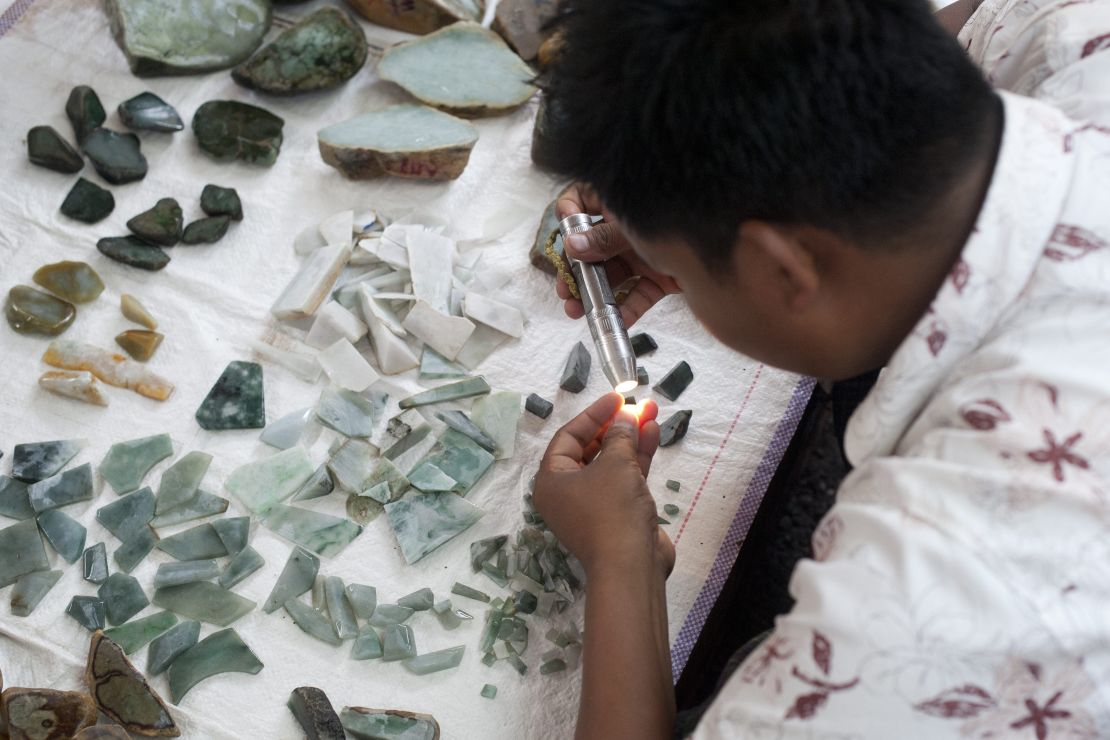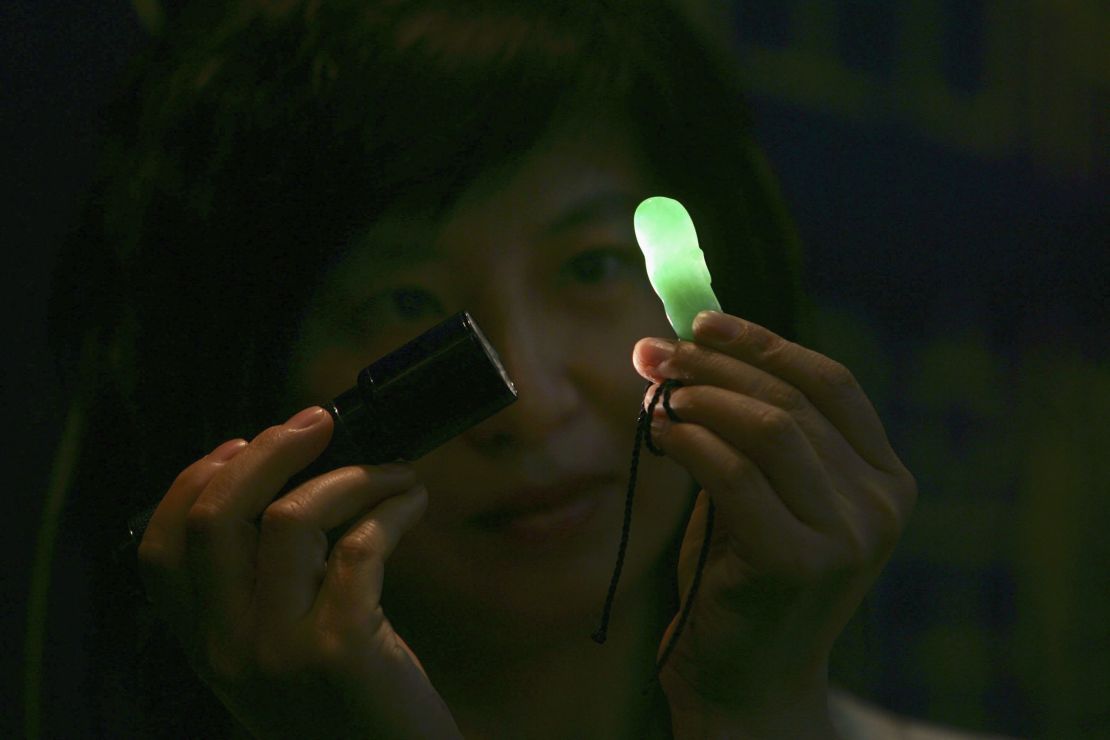To the untrained eye it’s a simple piece of jewelry – but don’t let its modesty fool you. This vivid, emerald green jadeite bangle is expected to sell for HK$50 million to HK$70 million ($6.5 to $9 million) when it goes under the hammer at a Sotheby’s auction in Hong Kong in October.
Jade is revered in China, with a cultural significance that dates back thousands of years and a value that was cemented by China’s Qing dynasty emperors, who prized it for its purity.
But as China’s rising wealth sees demand for jade jewelry grow, and supply out of Myanmar dwindles, prices for jade have risen exponentially, sparking a change in the styles preferred by Chinese buyers, and attracting a new group of Western admirers.
“With China opening up in the past decade, we have seen a new wave of collectors to the market. The auction market for jadeite has grown tremendously in the past 10 years,” explains Chin Yeow Quek, the chairman of international jewelery at Sotheby’s in Asia.
Fifty shades of jade
There’s no denying the rising price of jade. Aside from million-dollar bangles, jade jewelry of the the right color and quality, from necklaces to earrings and pendants, has all been attracting serious money.
The most expensive piece of jade jewelry – a necklace with a ruby and diamond clasp by Cartier that once belonged to the American heiress Barbara Hutton – sold at a Sotheby’s Hong Kong auction in April 2014 for $27.44 million, well above its $12.8 million estimate.
“It can be very crazy prices,” says Chiang Shiu-Fung, an associate vice president and jewelry specialist with Christie’s Asia, who quoted an old Chinese saying “gold has a value; jade is invaluable.”
However, not all jade is equal, and being able to differentiate between types and qualities – and being able to spot a fake – is critical, if not always easy. Jadeite, the purest, most translucent substance that comes in a multitude of colors, from deep greens to lavender, white, and black, is the hardest and most valuable form of the stone, and most often turned into jewelry.
Lesser quality nephrite, a softer, cloudier stone that comes in an even greater array of colors, is also classed as jade, but is more commonly used for carvings. Low quality industrial jade, and products made from cheaper-quality stone can also be treated by adding color or polymer to enhance the visual appeal of the stone to make it look like the real thing.

Although most experts can tell the difference between these products with a visual assessment, it’s not always reliable, and without any established international standard for guidance, even specialist jade experts can only be 80 to 90 percent sure whether a stone is pure jadeite using that method, according to Chiang.
“If you really want to be 100 percent sure that a piece is jadeite or some other kind of material, you have to send it to the laboratory,” he says.
Even if a product is found to be pure jade, any kind of adulteration or treatment significantly reduces the value of the stone, and Chiang says that only “totally untreated, natural jadeite” can be classified as an “A-grade” stone.
“In terms of the jewelry market, whatever gemstone it is, the natural one is the most desirable because it comes with natural beauty. Whatever humans can do artificially to improve the color, this kind of treatment lowers the value greatly.”
Supply-driven style
When it comes to high-quality jadeite, growing demand among China’s increasingly wealthy and middle classes have had a significant influence on rising prices. Dwindling raw jade stocks in Myanmar, which supplies the vast majority of the world’s jade and is the only source of high-quality stone, has also compounded the issue.

Auction houses in Asia, where the vast majority of jade is sold, say this has led to a change in the styles of jade being sought among collectors, with a growing emphasis on quality factors like color and translucency.
“While we saw consecutive records set in 2013 and 2014, Chinese collectors these days are becoming more selective and are after pieces that are truly special and rare,” says Sotheby’s Chin.
“Nowadays people are looking for simple items in terms of the style,” adds Chiang. “People, especially jadeite collectors, are looking for the material, the quality of the stone.”
On the retail end, the increased price and awareness of the stone has expanded the markets among Western buyers – Nicole Kidman and Jessica Chastain among them – and further segmented the market.

From a high-end retail perspective, personalization and uniqueness are the most important elements for customers according to Eddy Hui, the artistic director of Edward Chiu Jewellery Art in Hong Kong, who says that tastes differ between more traditional Asian customers and his growing Western clientele.
“Purchasing jadeite jewelry often comes with sentimental reason for general Chinese, and they pay attention to color and translucency. More Western clients are into fine workmanship, carving details, and they are crazy about originality,” he says.
Choosing wisely
Whatever the preference or budget, jade’s broad classification means it’s important to choose a piece wisely, and Chiang says there are a few key things laypeople can look out for when purchasing.
Firstly, the texture of the stone should be fine, as this enhances the stone’s natural translucency, which is itself is another critical factor – the more light that can be seen through a stone, the more lustrous and valuable it is.

The color of the stone also significantly influences jadeite’s value, and whether it’s green, lavender or white, the color should be as pure as possible, with a strong saturation and a bright tone.
“Let’s use green as an example: you have to go for straight green, purely green. When the green is a little bit bluish, forget about it,” explains Chiang.
Finally, bigger isn’t necessarily best.
“If you have to choose between a large, commercial-quality stone and a small, better quality stone, go for the small one. We are buying a gemstone, we are not buying a brick. Large doesn’t mean anything,” says Chiang.
But technicalities aside, jewelry designer Hui says it’s all a matter of choosing a reliable seller, and following your heart.
“Jade stones are like us: always unique,” he says. “Love at first sight is actually the best way to connect to your own piece. Like seeing Mr. Right, you know it when you feel it.”


















